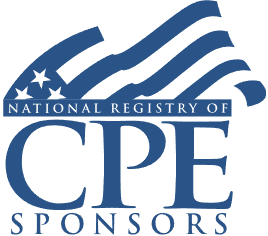Section 461(l) Excess Business Loss Limitations: Calculating and Preparing Form 461, Deficient IRS Guidance

Course Details
- smart_display Format
On-Demand
- signal_cellular_alt Difficulty Level
Intermediate
- work Practice Area
Tax Preparer
- event Date
Tuesday, January 7, 2025
- schedule Time
1:00 p.m. ET./10:00 a.m. PT
- timer Program Length
110 minutes
-
BARBRI is a NASBA CPE sponsor and this 110-minute webinar is accredited for 2.0 CPE credits.
-
BARBRI is an IRS-approved continuing education provider offering certified courses for Enrolled Agents (EA) and Tax Return Preparers (RTRP).
This webinar will provide tax advisers with a practical exploration of the loss limitation rules of Section 461(l). The panel will discuss what items are included or excluded in the business loss calculations, the effect of such a loss and its carryover to other taxable years, and the interactions with the passive activity loss rules and the Section 199A pass-through business income deduction.
Faculty

Ms. Lopez has more than 20 years experience with her concentration being income tax planning and compliance. She provides clients with tax, accounting, and consulting services delivered with professionalism and responsiveness. Ms. Lopez's clients are high-net-worth individuals, trusts and estates, and private foundations. Her responsibilities include tax engagement planning, budgeting, review and supervision. Ms. Lopez has successfully represented clients and the federal and state level for income tax and residency examinations.

Ms. Vercelli is a Tax Principal in BDO USA’s Private Client Services group and has more than 20 years of experience in tax compliance and tax planning for high net worth individuals and families. She also co-leads the firm’s private equity thought leadership initiative in the Private Client Services business line in the US and is an active member of the New York State Society of Certified Public Accountants (NYSSCPA). She currently serves on the Estate Planning Committee, where she is involved in the The Daily News Tax Panels in collaboration with the NYSSCPA. She is also a member of the American Institute of Certified Public Accountants (AICPA) and serves on the Georgetown University Alumni Admissions Program.

Ms. Singal is a Tax Partner in Anchin’s Consumer Products Group with more than 20 years of expertise in strategic tax planning and compliance. She specializes in planning for privately-held businesses in the manufacturing & distribution, wholesale and retail industries. Ms. Singal also serves law firms, architecture and engineering firms, real estate companies, family partnerships and private foundations. She frequently advises clients on mergers, acquisitions, and corporate restructuring, particularly within the manufacturing & distribution and real estate sectors. Ms. Singal expertise extends to international tax, and she has advised multinational businesses on the tax ramifications of inbound and outbound business activities.
Description
The Tax Cuts and Jobs Act (TCJA) introduced the excess business loss (EBL) limitation rules of Section 461(l). Originally scheduled to sunset Dec. 31, 2025, along with many other TCJA provisions, and suffering a suspension under the CARES Act for 2018-2020, a combination of extensions under the American Rescue Plan Act and the Inflation Reduction Act moved its expiration date to Dec. 31, 2028. Although extended, there remain unanswered questions concerning applying Section 461(l) requirements and how this legislation interacts with other tax provisions.
The law disallows the current deduction of any EBLs, a statutory creation under Section 461(l). These losses are generally the excess of the taxpayer's aggregate deductions attributable to trades or businesses over the sum of (1) the taxpayer's aggregate gross income or gain attributable to such trades or businesses and (2) $305,000 ($610,000 in the case of a joint return) for 2024. In other words, net business losses may offset only up to $305,000 or $610,000 of investment income and other non-business income.
Significant questions have arisen over whether various tax items are business or non-business for this purpose, such as wages and salaries, gain on the sale of partnership interests or S corporation stock, cancellation of debt (COD) income, the Section 199A pass-through business income deduction, and (ironically) certain losses from the disposition of business property.
EBLs are carried forward as a net operating loss (NOL), but there is some uncertainty and debate over how to apply the carryover rules. The NOL can offset only up to 80 percent of pre-NOL taxable income in the carryover year. Although several identified technical corrections exist for Section 461(l), there is still a lack of official guidance, and a relative scarcity of academic or practitioner commentaries on critical issues.
Listen as our experienced panel provides a practical guide to the current state of Section 461(l) as it applies to non-corporate taxpayers.
Outline
- Section 461(l) overview
- Effect of EBL and carryover
- Calculating EBL
- Interactions with other Code provisions
- Items awaiting future IRS guidance
Benefits
The panel will discuss these and other relevant topics:
- Other Code provisions that may be analogous and help in computing EBL
- Treatment of partnership and S corporation items for their partners and shareholders
- The intersection of EBL with Section 199A qualified business loss carryovers
- Impact of Section 461(l) on passive and non-passive activities
NASBA Details
Learning Objectives
After completing this course, you will be able to:
- Determine how to calculate EBL within a partnership setting
- Discern how the EBL limitations and caps on deductibility of NOL carryforwards can create tax liability
- Identify how to allocate disallowed EBLs as NOL carryforwards on a partner-by-partner basis
- Ascertain how the 461(l) guidelines interact with other tax provisions
- Field of Study: Taxes
- Level of Knowledge: Intermediate
- Advance Preparation: None
- Teaching Method: Seminar/Lecture
- Delivery Method: Group-Internet (via computer)
- Attendance Monitoring Method: Attendance is monitored electronically via a participant's PIN and through a series of attendance verification prompts displayed throughout the program
- Prerequisite: Three years+ business or public firm experience at mid-level within the organization, preparing complex tax forms and schedules; supervisory authority over other preparers/accountants. Working knowledge of partnership/corporate structure. Foundational knowledge and understanding of calculating and reporting net operating losses for individuals and businesses; familiarity with Sec. 382 limitations and alternative minimum tax.

Strafford Publications, Inc. is registered with the National Association of State Boards of Accountancy (NASBA) as a sponsor of continuing professional education on the National Registry of CPE Sponsors. State boards of Accountancy have final authority on the acceptance of individual courses for CPE Credits. Complaints regarding registered sponsons may be submitted to NASBA through its website: www.nasbaregistry.org.

Strafford is an IRS-approved continuing education provider offering certified courses for Enrolled Agents (EA) and Tax Return Preparers (RTRP).
Unlimited access to premium CLE courses:
- Annual access
- Available live and on-demand
- Best for attorneys and legal professionals
Unlimited access to premium CPE courses.:
- Annual access
- Available live and on-demand
- Best for CPAs and tax professionals
Unlimited access to premium CLE, CPE, Professional Skills and Practice-Ready courses.:
- Annual access
- Available live and on-demand
- Best for legal, accounting, and tax professionals
Unlimited access to Professional Skills and Practice-Ready courses:
- Annual access
- Available on-demand
- Best for new attorneys
Related Courses

Admitting New Partners: Tax Consequences
Friday, May 30, 2025
1:00 p.m. ET./10:00 a.m. PT

Key Issues in Succession Planning: Buy-Sell Agreements, Equity Grants, Profits Interests, Tax Considerations
Tuesday, June 17, 2025
1:00 p.m. ET./10:00 a.m. PT
Recommended Resources
How CPE Can Bridge the Gap Between What You Know and What You Need to Know
- Career Advancement